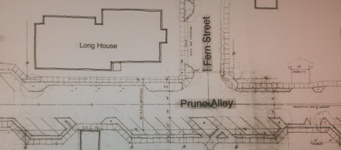— by Margie Doyle —
The Eastsound Planning Review Committee (EPRC) meets the first Thursday of each month from 3 to 5 p.m. at the Eastsound Fire Hall. Its next meeting is March 5. It is an advisory committee for the County, and its members are appointed by the County Council and serve without pay. Current members are Greg Ayers, Clyde Duke, Ken Katz, Gulliver Rankin, Jobin Suthergreen and Teri Williams.
At its most recent meeting, on Feb. 5, the EPRC discussed the four-year old Prune Alley Improvement Plan, the 12-year old Eastsound Sub-area Update (delayed once again while the county reviews compliance with proper notification) and a recent meeting with Clyde Duke and Ken Katz of the EPRC and the Orcas Island Chamber of Commerce Executive Director Lance Evans. County Councilman Rick Hughes joined the meeting by speakerphone half-way through.
As Duke reviewed the meeting with Evans, who was in attendance at the EPRC meeting, a discussion of lighting for Eastsound street came up, prompted by recent OPALCO work near Main Street. After talking about different varieties of lighting that might be installed
- Knee-length height like in front of Hogstone Pizza on Main Street and Haven Road
- 8-12 ft. high at identified “dark” areas, such as “A” Street
- At crossroads only
- Motion-activated
the conversation turned to funding. The EPRC asked Evans if the Chamber may be able to align with EPRC for street lights. As a 501(c)6 non-profit,the Chamber doesn’t give charitable contributions, but it does work with the Orcas Island Community Foundation (OICF) on civic improvement funds, for items such as trash cans, Evans said.
Other funding possibilities mentioned were county .09 funds or through the county Economic Development Council EDC, through a Local Improvement District (LID) with the sewer and water district, or the Port of Orcas. The Eastsound Water Users Association (EWUA) has abandoned water lines that might be used for conduit.
Follow-through on funding has been a problem in the past, such as maintenance of the county restrooms next to the Eastsound Village Green or pick-up of trash cans with a lack of clarity as to which entity assumes those responsibilities — private contractors or Public Works or Solid Waste or the Parks Department?
The EPRC also suggested coordinating with OPALCO’s installation of fiber optics in order to share costs of trenching for lighting cables. Later in the meeting, when County Councilman Rick Hughes joined by conference call, he said, “The County is in conversations with OPALCO to install fiber optics and lighting.”
Gulliver Rankin said that the county could pay for the wire, but “I have no faith in county to come up with funds to get lighting done. Whatever solution comes up with, we shouldn’t count on it coming from the county.”
Evans said the Chamber and EPRC should, “Aim high with the County and see the reality that’s left.”
Duke said that a decision on installation of street lighting, “needs direction from the community on what we want, much like the Streetscape Plan.” He proposed a joint meeting in March with the County Council and Orcas Chamber, as a start for community discussion on trash and bathrooms as well as lighting
Eastsound Sub-area Plan update:
The EPRC brought up the “pushback” from businesses on the subarea plan and asked if businesses feel they understand the plan and the next steps. Evans said, “It’s not a topic we’ve made sure they know what’s looming. It’s tough for folks to invest their time in.”
Duke asked that the Chamber direct people in its weekly Chamber “Blast” or separate emails to advise people to consult the Sub-area Plan on the County website. “We need to do anything and everything we can do to engage them.”
John Campbell, longtime member of the Eastsound Design Review Committee, attended the meeting and pointed out the inclusion of rural uses in urban zones and vice versa. Campbell noted that farm labor accommodations and farm stays are permitted in the urban Eastsound column, and also that residential uses are permitted in rural zones. “The conflict is too great to overlook, we need another column for both inside and outside UGA,” maintained Campbell.
In 2014, Campbell spoke to the EPRC about proper notification for those lots re-zoned in the proposed changes to the Eastsound Sub-area Plan.
The EPRC said that, to move forward in the Sub-area Update, they now need a date on the county docket that notifies all county residents of the proposed changes, not just to adjacent property owners. As the EPRC has lost its place for update of the Sub-area plan on the county docket, they are now looking at late this year before the plan can be reviewed by the Planning Commission and County Council.
Prune Alley Improvements
Since 2011, the EPRC has worked to install sidewalks, curbs and gutters on parts of Prune Alley between Main Street and School Road. Klein and Bill Trogdon met with property owners over a two-year period to gain their assent to the plans.
Klein said that the Chamber, with current president Susan Gudgell and Board Member Mary Clure, had written a letter to County Manager Mike Thomas, asking for assurance that the county keep “the Chamber in the loop to give strong support to getting [the Prune Alley Improvements] off the dime.”
Klein reported that another letter, from the EPRC to Thomas, “asking him to move ahead on acquisition for parking and sidewalks,” was met with Thomas’ reluctance to “go ahead until he had 40% engineering for Prune Alley.”
Duke said that the typical process began with 40% engineering, and added, “I didn’t hear pushback, but did you hear commitment?” Duke advised drafting a follow-up letter regarding the meeting and the next steps.
Klein said, “What’s missing for me is moving ahead with engineering, but if the County doesn’t have money or staff for engineering and that’s going to be put off into the future, then that’s not okay with me. How do we find that out?”
Duke responded, “I think we have traction; I’d like to think by next month we’ll have the opportunity to focus on specific questions to clarify what steps are being taken.”
Campbell said that the Klein/Trogdon plan submitted to the County for Prune Alley was “a good start.” Overall, the Prune Alley street scape is one of varied landscaping and parking features as opposed to a ‘one size fits all’ design from School Road to Main Street, Campbell said.
He asked what percentage of engineering is currently completed for the project, and was told that County Engineer Rachel Dietzman had obtained funding for part of the project addressing stormwater issues at Fern Street and at Main Street on Prune Alley. However, he noted that the partial engineering plan that was shown to the EPRC for those areas, was “unacceptable.”
Duke said the EPRC needed to “get agreement on that from the county. We’d agreed Shannon Wilbur would be engineer; the timeline issue and benchmarks are what should be put together.”
In the teleconference with Rick Hughes, Klein asked him to elaborate on the conversation that had occurred with Mike Thomas, Clyde Duke, John Campbell and both Hughes and Klein. Hughes said, “We need to be clear where things are at. We would like to have buy-in that was approved by EPRC and the community, and, we thought, by the county.
“My goal is to utilize the hard work and effort and put into a CAD format… that specific property needs were addressed. I’d like to move forward and I think Mike Thomas is in agreement. We need to figure out how to move ahead with design and a good plan.”
Hughes was also asked to revisit the designation of the Public Works lot west of the Village Green as a “transportation hub.” He replied that he would like to see a joint effort with EPRC and Public Works with Klein as the point person.
However, Klein said, “Public Works has decided they don’t want to have a liaison person regarding Prune Alley.” Duke said he’d “heard clearly” on Feb. 4, that the EPRC had unanimously voted that Klein was to be the representative, and Shannon Wilbur to be the engineer overseeing the project. Rick Hughes agreed.
Before the meeting adjourned, the ERPC agreed that it would write a letter to the County Council to ask the Council to direct Public Works to open the path through that lot, closed since 2014.
Fred Klein also reported before the close of the meeting that the county’s case against Leo Lambiel’s Greek “temple” on his property “has been closed and all outstanding issues are resolved.”
**If you are reading theOrcasonian for free, thank your fellow islanders. If you would like to support theOrcasonian CLICK HERE to set your modestly-priced, voluntary subscription. Otherwise, no worries; we’re happy to share with you.**









Unbelievable. I would venture to say most of us moved here for the charming, retro-feel of a small town, including undeveloped/unimproved roads.
What used to be lovely, winding roads – have been straightened, trees removed, widened, bike paths walking paths, guard rails, and now street lights in Eastsound? You have got to be kidding me.
There is an email/internet “joke” going around about how people survived without bike helmets, iphones, internet, and the list goes on and on.
I have never felt like a NIMBY, but if one wants the “amenities” of a city, stay in The City!
There is no need for street lighting in Eastsound.
None at all.
Are people stumbling around and falling down?
I don’t think so.
Are there muggings and robberies on our streets?
I haven’t heard of even one.
How ’bout vehicle accidents, or mowed-down bikes?
None of those, either.
So, what good will street lighting do?
Who will benefit — beyond the contractors doing the installation, that is?
I know what bad it will do:
Light pollution will further wipe out our view of the stars.
Eastsound Village will look like Seattle, or Bellingham, or something even worse.
Eastsound does not need street lighting.
When North Beach Road was dirt and gravel, Cherie Lindholm and Con Davis installed sidewalks on A street only to be told 15 years later by the “planners” that we needed to replace them and create tree lined parking places. Our remodeled building was stated to be “like it belongs in Friday Harbor” what ever that meant. Maybe you remember when the new Island Market was built there were huge complaints about it being too bright at night…I dont think we need street lights.
I do think some kind of streetlights would help in Eastsound, tho very minimal. Many times when I have driven through town around dusk, I have nearly hit jaywalkers, bicyclists with inadequate lighting, or people crossing at corners, because it is nearly impossible to see them when you have the headlights of oncoming traffic at dusk or in the dark. And I drive very slow and careful. I feel it is a safety issue and again, lighting kept at a minimum.
Please please please no lights in Eastsound. My car has its own headlights, and I can carry a flashlight or wear a headlamp if I feel the need. I second everything Steve Henigson said, and I also support Laurel’s comment that driving slowly and carefully is a good thing. Where I am now in Newark, Delaware (my other home) it is like daylight ALL THE TIME outside because it’s a college town and the city has decided it’s necessary (and it’s complete overkill, by the way). Once you take away the darkness, it’s very hard to get it back!
People, it’s 2015. Eastsound is no longer the sleepy little backwoods farm crossroads that it was. It’s a thriving center of commerce serving both locals and tourists. It is the Urban Growth Area of Orcas and needs street lights, sidewalks, bike paths, and trash receptacles for the obvious reasons of safety, cleanliness and encouraging people to get out of their cars.
No, Eastsound is still a rural town. It’s an urban growth area because the state growth management act demands that one exist somewhere, and that most growth happen there. The ONLY reason that it’s a thriving center at all is that tourists come for the charming little crossroads that it is. Streetlights, multi-lane widened roads, $3 million concrete bridges replacing little wooden bridges–I don’t know anyone who signed on for this on Orcas.
Some progress is good and useful and helpful to public safety. Trash receptacles are great. Maybe a little more lighting. Many people have put a lot of time and thought into these proposals. However, changes need to take into account the history, character, proportions and usage of Eastsound. If we wanted to live in modern suburbia, we would. Instead, we live here. For the record, not all of the Prune Alley property owners gave their glad assent to the proposals for that street.
Walking along Prune Alley is very dangerous, especially at night! Also, as Peg says, the most growth will happen in Eastsound. Let’s plan for the future! Good job EPRC!
Streetlights throughout Eastsound? Seriously?
This is driven by the same small group of people that gave us stop signs at Nordstrom lane & Crow Valley Rd., stop signs at the Enzo’s /Teezers corner, a winding widening of Mt. Baker Road, medical “surveys” that only benefit OIMC and a $21 MILLION tax for Orcas Fire.
Welcome to the new Orcas Island.
The intersection at “A” Street and North Beach Road is one of the busiest in the county. It definitely needs stop signs. I moved to the islands in 1978 when the population was 1/3 of what it is today. We need to get used to it, and meet the needs of the 2015 Orcas Island!
We’ll also have a freeway-sized $3 million bridge replacing the charming Deer Harbor bridge, plus more “straightening” on Orcas Road. How did we survive all these years without these modern wonders?
I wonder if anyone has noticed the 3 or 4 globe streetlight next to the Outlook Inn? I don’t know architecturally if it’s in the right era for the Inn, but it’s attractive, very low light, and unobtrusive (wonder if it even works?), and I bet helps those turning into to Inn’s driveway. As Moana said it right: history, character, proportions & usage have to be kept in mind. Low lights would be bad, anywhere.
Can someone explain to me why our elected officials and other community “leaders” do not get the message that the overwhelming majority of us living on this island came here precisely because of its rural character and in the hopes that character would be preserved forever. So many of the “improvements” in the last few years have been misguided and a blight on our beautiful island. Those garish, over-sized orange street signs are a metaphor for everything wrong with taking federal and state money just because its available and using those funds to turn Orcas Island into the “mainland”. Count me with the many voices here asking for a re-think on street lighting and other unneeded “improvements” to Eastsound.
We have visited Orcas twice in the off season, with shorter/darker days. There really was no problem with getting around after dark. We felt safe and could easily find our way. Not sure that lights are really necessary.
Please! Not Martha’s Vineyard! ! !
I am definitely in favor of huge street lights, some traffic
signals along with more sidewalks and I think also some bill-
boards. Last week I was almost attacked by a deer while
walking in town. I am sure that I would have seen him more
clearly if we had more street lights. Imagine how much safer
we would be from these animal attacks. Also, billboards would
warn people of the danger of ferocious wild animals that roam
are streets. This whole discussion is ridiculous.
From what I understand, a number of years ago when they were putting in the sidewalks in Eastsound, they put in some empty conduit so that in the future they might use this to add street lights. Great thing to do when everything is torn up.
Fast forward to today.
OPALCO/RockIsland wants to try and hook up business in Eastsound to their fiber network. But, they need to trench in Eastsound to do this. BUT wait, there is empty conduit in the ground. They asked to use this conduit, which I think is a great use for it.
But, I bet that the county wants OPALCO to put in street lights as payment for letting them use the empty conduit, or something along those lines. I could be wrong though.
Street lights seem rather silly. Putting fiber in those empty conduits seems like a great idea to me. And whoever put the empty conduit in the ground years ago should be given a medal.
Bill Gincig’ beautifully ironic note left out the most important, most necessary improvement of all: A bridge to the mainland.
Build that, and our little paradise would be complete!
I can’t wait.
Perhaps the plan could work in a nice underground parking garage next to the new WalMart. Hopefully we’ll get one of the good ones, with a McDonalds inside….
Just for clarity…the proposed “street lights” are 3 feet or knee high tall. Illumination would be pointed to the ground. Path lighting would be a better term. I am not pro or con lighting. I am pro facts.
Please edit my comment above, concerning my use of “low lights”. I meant 3 foot high, pointed at the ground lights are bad; they’d be in the way, and not illuminating what you want to be seen: people crossing at a few intersections. I do mean “low light” is good to have in a few tall lights, if ever erected at those key intersection spots, such as what I mentioned at Outlook Inn.
Are any of the naysaying streetlight-haters here actual business owners of the establishments along Main Street, Northbeach Road, Prune Alley and “A” Street? These are not residential streets, they are almost completely lined with businesses! Why don’t we ask these owners if they want a few low-key, well placed lights in the business section of town? Is it really anybody else’s business? If you’re really so worried about destroying the rural nature of town, get out of your noisy, polluting cars and walk or ride a bike! Then the streets could be kept narrow with no sidewalks, too.
“Streetlight haters.” I love it. Nasty labels always make the conversation clearer and more rational.
And further, he’s quite convinced that these “streetlight haters” are also mere “noisy, polluting” drive-bys, not strollers and saunterers.
My, the conclusions one needs to jump to, in order to affix unpleasant labels upon opposing ideas!
But using nasty, judgmental labels does save having to actually think.
Just simple observations, Steve, but ok then, “naysaying streetlight dislikers”, if you like that better! It’s just that if it looks like a duck and walks like a duck, it’s probably a duck. Also, I’m in position to view Eastsound passerbys all day. I’d say it’s about 98% car vehicle traffic and very few strollers and saunterers, and most of those are just going from their car into the stores. Maybe with some nice sidewalks and a few attractive, quaint street lights, we would see more walkers.
Out of all the topics they’re visiting… Everyone is hung up on street lights…? Is no one disturbed by the idea of a ‘transportation hub’….? Or some of the other ideas?
As a business owner, I wouldn’t mind a few strategically-placed, unobtrusive lights in some of the decidedly darker areas. Especially after news of burglaries and vandalism in recent years. Lighting, even a very little bit, is proven to deter. I think some folks might hear “street light” and think “towering metal pole with a huge bright light,” but there are more agreeable options.
Erica–we already complained about the transportation hub, and that was ignored as much as the concerns about streetlights and other suburbanization of the island. Surrender. The bureaucrats continue to grind along, doing what they want to do.